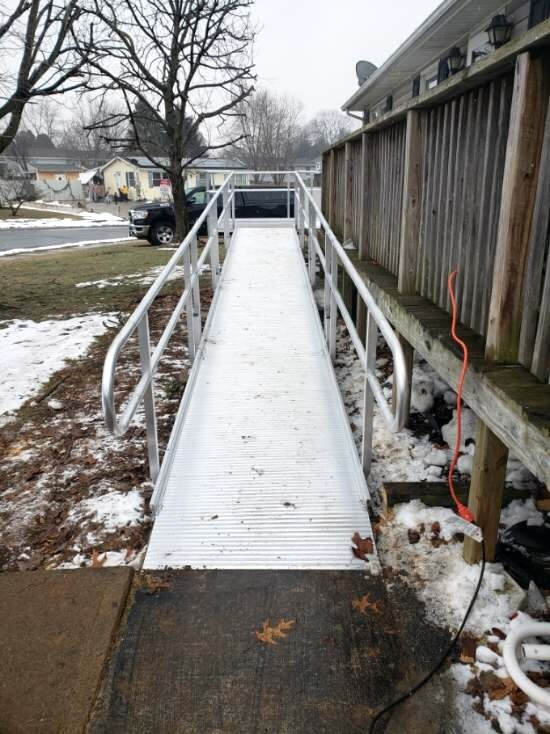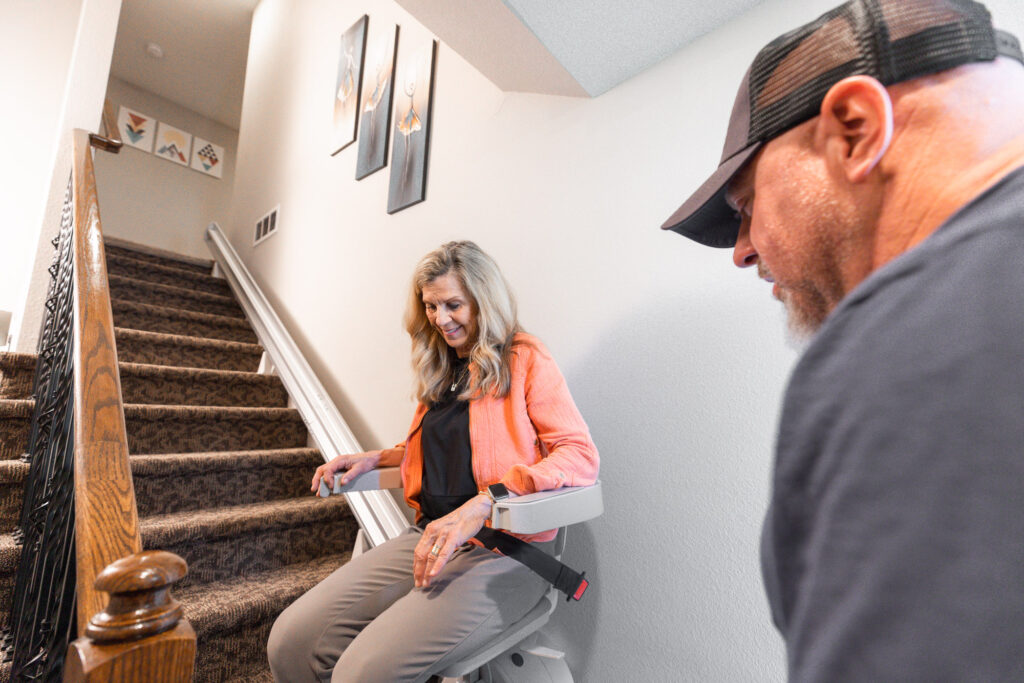
Whether you’re caring for an aging parent, recovering from surgery, or planning for future mobility needs, finding the right wheelchair ramp in Central Pennsylvania can feel confusing. You need to know where to look, what to ask for, and how to ensure you’re getting a quality product that will last.
If you’re searching for wheelchair ramps in Harrisburg, Reading, York, or Lancaster, you have several good options—from local providers who understand Pennsylvania’s winters to online retailers with bigger selections. Here’s how to make the best choice for your situation and budget.
Local vs. Online: Where to Buy Wheelchair Ramps in Central Pennsylvania
Local Wheelchair Ramp Providers in the Harrisburg Area
Buying from local providers in Central Pennsylvania has advantages, especially when dealing with snow, ice, and hilly terrain. Local companies know Pennsylvania building codes, can look at your property, and stick around to help if you have problems later.
Independent Home Solutions serves Harrisburg, Reading, York, and Lancaster with wheelchair ramp solutions that work for your home. Local providers can visit your home, look at what you need, and recommend ramps that will hold up in Pennsylvania weather. We’re also there for follow-up service and any problems that come up.
You also get immediate help when needed, face-to-face conversations, and support from businesses that deal with Central Pennsylvania’s accessibility challenges every day—from row home steps in Lancaster to ranch homes in York County.
Online Wheelchair Ramp Shopping
Online retailers have bigger selections and better prices, but you’re on your own for research. You’ll find everything from simple threshold ramps to complex modular systems, usually cheaper than local stores. But you’ll need to measure carefully, figure out the installation yourself, and handle any problems without local help.
You’ll find medical supply companies, accessibility specialists, and big retailers online. The selection is huge, but make sure any ramp you buy meets ADA guidelines and can handle Pennsylvania winters.
Getting the Best of Both
Many Pennsylvania residents research options online first to see what’s out there, then work with local providers for professional assessment and installation. You get the right product with proper local support.
How to Determine if a Wheelchair Ramp is Right for Your Situation
Assessing Your Mobility Needs
Before shopping for wheelchair ramps in Harrisburg or the surrounding area, consider your current and future mobility needs honestly. Are you dealing with something temporary, like surgery recovery, or planning for long-term accessibility? This affects whether you need a permanent ramp or something portable.
Think about who will use the ramp. Manual wheelchair users need different things from power wheelchair users. Someone who can walk short distances but uses a wheelchair for longer trips has different needs than someone who relies on their wheelchair all the time.
Evaluating Your Property
Your home’s layout makes a big difference in ramp selection. Row homes in Lancaster and Harrisburg often have tight spaces and steep entry steps, so you need to plan carefully. Suburban homes in York County might have more room for longer, gentler ramps.
Take accurate measurements of your entrance height, available space, and consider how a ramp will affect your home’s appearance and your neighbors’ access. Some Central Pennsylvania communities have homeowner association guidelines that may affect ramp installation.
Weather and Seasonal Considerations
Pennsylvania winters are tough on accessibility equipment. Your wheelchair ramp must handle snow, ice, freezing temperatures, and the salt used on many Central Pennsylvania roads and sidewalks. This affects both material choice and maintenance requirements.
Consider whether you’ll need year-round outdoor storage for a portable ramp, or if a permanent installation makes more sense. Factor in snow removal access and how winter weather might affect daily use.
How to Check Wheelchair Ramp Quality: What Central PA Residents Need to Know
Material Quality for Pennsylvania Weather
Aluminum ramps are popular in Central Pennsylvania because they resist rust and corrosion from road salt while remaining lightweight. However, not all aluminum is equal—look for ramps with thick aluminum construction and powder-coated finishes that can withstand our freeze-thaw cycles.
Steel ramps are durable but need a special coating to prevent rust in Pennsylvania’s climate. Wooden ramps may also work well, but will require regular maintenance and treatment for moisture and temperature changes.
Construction and Safety Features
Quality wheelchair ramps include several key safety features essential for Pennsylvania conditions. Non-slip surfaces are crucial—textured aluminum or applied grip strips help prevent accidents on wet or icy surfaces. Side rails should be sturdy enough to provide support and avoid accidents.
Check weight capacity carefully. The ramp should safely support not just the wheelchair user but also any caregivers who might need to assist. Most quality ramps support at least 600-800 pounds, but verify this matches your needs.
Certification and Compliance
Ensure any ramp you’re considering meets ADA (Americans with Disabilities Act) guidelines for slope, width, and safety features. While private homes aren’t required to meet ADA standards, these guidelines represent best practices for safe, usable ramps.
Look for ramps that meet or exceed local building codes. In Pennsylvania, this might include specific requirements for railings, load capacity, and installation methods. Reputable manufacturers will clearly state their compliance with relevant standards.
Getting a Wheelchair Ramp That Lasts: Durability in Central Pennsylvania
Planning for Long-term Use
When investing in a wheelchair ramp in Harrisburg or surrounding areas, think beyond immediate needs. Mobility requirements often change over time, and a well-chosen ramp can adapt to evolving situations. Modular ramps offer flexibility—you can add sections or reconfigure as needed.
Consider the total cost of ownership, including maintenance, potential repairs, and eventual replacement. A higher-quality ramp that lasts 15-20 years often costs less than replacing a cheaper ramp multiple times.
Maintenance in Pennsylvania Climate
Central Pennsylvania’s weather demands regular ramp maintenance. Plan for seasonal cleaning to remove salt residue, periodically inspect joints and fasteners, and occasionally apply surface treatment to maintain grip and appearance.
Quality manufacturers provide maintenance guidelines specific to different climates. Some offer maintenance services or can recommend local contractors familiar with their products.
Warranty and Support
Find manufacturers that offer comprehensive warranties for their products. The best wheelchair ramp companies offer multi-year warranties covering materials, workmanship, and sometimes even installation.
Equally important is ongoing support. Can you get replacement parts years later? Is there a local service network? Companies with a strong local presence in Central Pennsylvania can provide better long-term support than distant manufacturers.
Choosing the Right Size and Length for Your Wheelchair Ramp
Understanding ADA Slope Guidelines
The standard ADA recommendation is a 1:12 slope ratio—one foot of ramp length for every inch of rise. For a typical Pennsylvania home with 24 inches from the ground to the door, you’d need a 24-foot ramp. However, gentler slopes (1:16 or 1:20) are easier and safer to navigate, especially for manual wheelchair users.
Consider the user’s strength and endurance. A longer, gentler ramp might be better for someone with limited upper body strength, while a steeper ramp might work fine for power wheelchair users with good control.
Space Constraints in Central Pennsylvania
Many Central Pennsylvania homes, especially in urban areas like Harrisburg and Lancaster, have limited yard space. This might require creative solutions like switchback ramps (ramps that change direction) or platforms that allow turns.
Measure carefully and consider how the ramp affects other property uses. Will it block access to basement entrances, garden areas, or parking? Can emergency vehicles still access your home if needed?
Width Requirements
Standard wheelchair ramps should be at least 36 inches wide for single-direction use. If caregivers need to walk alongside the wheelchair user, or if the ramp might accommodate two-way traffic, consider 48-60 inch widths.
Think about future needs, too. While a narrow ramp might work for a standard wheelchair, it could be inadequate if the user later needs a power chair or scooter.
DIY Installation vs. Professional Installation in Central Pennsylvania
When DIY Makes Sense
Simple threshold ramps and some portable ramps can be DIY projects for handy homeowners. These typically don’t require permits and involve minimal structural work. However, even “simple” installations require careful attention to safety and local building codes.
Consider your skills. Working with materials like steel or aluminum requires specific tools and experience. You’ll need to ensure it slopes properly while creating safe railings. Mistakes in ramp construction can lead to injuries.
Benefits of Professional Installation
Professional installers bring experience with Pennsylvania building codes, local permit requirements, and weather-specific installation techniques. They understand how frost heaving affects foundations and how to anchor ramps for long-term stability.
Professional installation often includes warranties on both materials and quality. If something goes wrong, you have recourse. They also handle permits and inspections, ensuring your ramp meets all local requirements.
Cost Considerations
While DIY installation saves labor costs, factor in tool purchases, permit fees, and the value of your time, professional installation typically adds 30-50% to material costs but includes expertise, warranties, and often faster completion.
Professional installation often proves more cost-effective long-term for complex installations or permanent ramps. Mistakes in DIY installation can be expensive to correct and potentially dangerous.
Key Takeaways: Wheelchair Ramps for Central Pennsylvania Residents
- Choose local when possible: Providers in Harrisburg, Reading, York, and Lancaster understand Pennsylvania weather and building codes.
- Plan for weather: Select materials and features that handle Central Pennsylvania’s challenging climate
- Consider future needs: Mobility requirements often change—choose ramps that can adapt.
- Professional installation pays off: Professional installation ensures safety and compliance for permanent ramps.
- Quality matters: Invest in ramps that will last through Pennsylvania winters and provide reliable access
- Measure twice, buy once: Accurate measurements and honest needs assessment prevent costly mistakes.
Frequently Asked Questions About Wheelchair Ramps in Central Pennsylvania
Do I need a permit for a wheelchair ramp in Harrisburg?
Permit requirements vary by municipality in Central Pennsylvania. Many areas require permits for permanent ramps, but not temporary or portable ones. Check with your local building department in Harrisburg, Reading, York, or Lancaster before installation.
What’s the best material for wheelchair ramps in Pennsylvania weather?
Aluminum with powder coating typically performs best in Pennsylvania’s climate. It resists corrosion from road salt, handles freeze-thaw cycles well, and requires minimal maintenance. Steel can work, but it needs proper coating, while wood requires regular maintenance.
How much do wheelchair ramps cost in the Harrisburg area?
Costs vary widely based on length, materials, and installation complexity. Basic portable ramps start around $200-500, while permanent installations typically range from $1,500-5,000. Complex installations or premium materials can cost more. Local providers can provide accurate estimates based on your specific situation.
Can I rent a wheelchair ramp instead of buying one?
Yes, several Central Pennsylvania medical supply companies offer wheelchair ramp rentals. This makes sense for temporary needs like post-surgery recovery. However, for long-term use, purchasing often proves more economical.
How do I maintain my wheelchair ramp in Pennsylvania winters?
Regular cleaning to remove salt residue is essential. Keep the surface clear of ice and snow for safety. Inspect fasteners and joints seasonally, as freeze-thaw cycles can loosen connections. Apply grip treatments as needed to maintain traction.
What width wheelchair ramp do I need?
Minimum width is 36 inches for single-direction use. Consider 48-60 inches if caregivers need to walk alongside or for two-way access. Power wheelchairs and scooters may require wider ramps for comfortable maneuvering.


